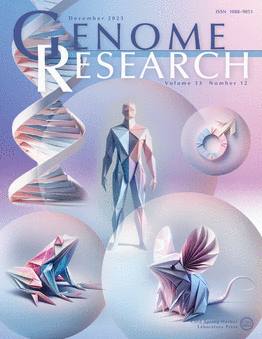动态屏障调节内聚定位和基因组折叠在固定占用
IF 5.5
2区 生物学
Q1 BIOCHEMISTRY & MOLECULAR BIOLOGY
引用次数: 0
摘要
在哺乳动物间期细胞中,基因组通过受定向CTCF屏障限制的内聚蛋白环挤压折叠。这一过程丰富了屏障上的内聚蛋白,隔离了邻近的拓扑相关结构域,并提高了整个基因组中收敛的CTCF屏障之间的接触频率。然而,最近的体内测量提出了一个难题:报道的CTCF在染色质上的停留时间在几分钟的范围内,而黏结蛋白的寿命要长得多。观察到的基因组折叠的特征是由相对短暂的屏障引起的吗?为了解决这个问题,我们开发了一个动态屏障模型,其中CTCF位点在绑定和未绑定状态之间切换。使用该模型,我们研究了屏障动力学如何影响一系列实验基因组和成像数据集的观察结果,包括ChIP-seq, Hi-C和显微镜。我们发现CTCF和内聚蛋白结合时间尺度的相互作用影响了这些特征的强度,即使在基因组数据集提供的种群平均快照中也留下了屏障动态的特征。首先,除了屏障占用外,屏障结合时间对于指导基因组折叠的特征至关重要。其次,边界与挤出机寿命的比值极大地改变了模拟ChIP-seq和模拟Hi-C。第三,在延长挤出机寿命后,通过实验观察到的染色体形态的大规模变化需要动态屏障。通过整合多种来源的实验数据,我们的生物物理模型表明,CTCF屏障结合时间有效地接近黏结剂挤出机的寿命。总之,我们展示了生物物理测量的蛋白质动力学模型如何拓宽了我们对基因组折叠的理解。本文章由计算机程序翻译,如有差异,请以英文原文为准。
Dynamic barriers modulate cohesin positioning and genome folding at fixed occupancy
In mammalian interphase cells, genomes are folded by cohesin loop extrusion limited by directional CTCF barriers. This process enriches cohesin at barriers, isolates neighboring topologically associating domains, and elevates contact frequency between convergent CTCF barriers across the genome. However, recent in vivo measurements present a puzzle: reported CTCF residence times on chromatin are in the range of a few minutes, whereas cohesin lifetimes are much longer. Can the observed features of genome folding result from relatively transient barriers? To address this question, we develop a dynamic barrier model, where CTCF sites switch between bound and unbound states. Using this model, we investigate how barrier dynamics would impact observables for a range of experimental genomic and imaging data sets, including ChIP-seq, Hi-C, and microscopy. We find the interplay of CTCF and cohesin binding timescales influence the strength of each of these features, leaving a signature of barrier dynamics even in the population-averaged snapshots offered by genomic data sets. First, in addition to barrier occupancy, barrier bound times are crucial for instructing features of genome folding. Second, the ratio of boundary to extruder lifetime greatly alters simulated ChIP-seq and simulated Hi-C. Third, large-scale changes in chromosome morphology observed experimentally after increasing extruder lifetime require dynamic barriers. By integrating multiple sources of experimental data, our biophysical model argues that CTCF barrier bound times effectively approach those of cohesin extruder lifetimes. Together, we demonstrate how models that are informed by biophysically measured protein dynamics broaden our understanding of genome folding.
求助全文
通过发布文献求助,成功后即可免费获取论文全文。
去求助
来源期刊

Genome research
生物-生化与分子生物学
CiteScore
12.40
自引率
1.40%
发文量
140
审稿时长
6 months
期刊介绍:
Launched in 1995, Genome Research is an international, continuously published, peer-reviewed journal that focuses on research that provides novel insights into the genome biology of all organisms, including advances in genomic medicine.
Among the topics considered by the journal are genome structure and function, comparative genomics, molecular evolution, genome-scale quantitative and population genetics, proteomics, epigenomics, and systems biology. The journal also features exciting gene discoveries and reports of cutting-edge computational biology and high-throughput methodologies.
New data in these areas are published as research papers, or methods and resource reports that provide novel information on technologies or tools that will be of interest to a broad readership. Complete data sets are presented electronically on the journal''s web site where appropriate. The journal also provides Reviews, Perspectives, and Insight/Outlook articles, which present commentary on the latest advances published both here and elsewhere, placing such progress in its broader biological context.
 求助内容:
求助内容: 应助结果提醒方式:
应助结果提醒方式:


